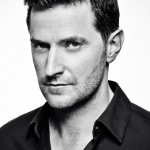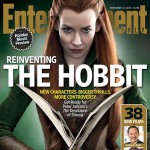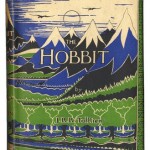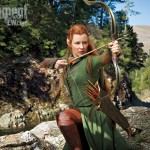 Last week, TORn staffer greendragon caught up with Thorin himself, for a chat about topics including what he is planning post Middle-earth, the upcoming release of The Hobbit: The Desolation of Smaug, and whether to go dressed as Sally Bowles to the Berlin premiere of said movie. (Answer: it seems unlikely that either greendragon or Richard Armitage will be at the premiere in stockings and a bowler hat…)
Last week, TORn staffer greendragon caught up with Thorin himself, for a chat about topics including what he is planning post Middle-earth, the upcoming release of The Hobbit: The Desolation of Smaug, and whether to go dressed as Sally Bowles to the Berlin premiere of said movie. (Answer: it seems unlikely that either greendragon or Richard Armitage will be at the premiere in stockings and a bowler hat…)
Look for most of the interview in a post later this week. Meanwhile, we here at TheOneRing.net have been pondering the division in fandom which seems to be being created by the Hobbit movies; and this interview seemed like a great opportunity to get Armitage’s thoughts on the subject.
Peter Jackson famously remarked (to Empire magazine):
‘This will probably get me struck off The One Ring party list, but I am enjoying deviating from the book!’
In creating his three movies, Jackson and his co-writers have added to, adapted and extended the story of the book, even coming up with entirely new characters. These changes have sparked debate amongst fans, and have in some cases caused deep rifts. Entertainment Weekly, in its ‘Reinventing The Hobbit’ issue (November 15 2013), calls Jackson’s embellishments ‘bold detours’, and writes:
‘On the fansite TheOneRing.net, debate over the first Hobbit film has raged for so long that one recent post pleaded for a détente: “Those who love the movie are ‘delusional’ and those that hate it are ‘radical purists’. For heaven’s sake, I feel like I am observing 8-year-olds fighting on the playground!’ ‘
 [Read the whole article here; where it is audaciously titled, ‘The Epic: Building a better Hobbit’!]
[Read the whole article here; where it is audaciously titled, ‘The Epic: Building a better Hobbit’!]
So how does a cast member who is known for his devotion to the book feel about these divisions? Here’s what Armitage had to say, about deviating from Tolkien’s words, and about a possible need for female characters in Middle-earth:
greendragon: There’s a strong positive side of fandom; but there’s been quite a lot of talk recently about some of the more negative reactions from fans. There seems to have been a lot of very vehement reaction – some fans have really been split into the book purists versus the movie lovers. Of all the cast, you seem to be someone who’s a book devotee; I wondered how you feel about the deviations from the book which the movies are taking?
RA: Yeah, you know what, I am a bit of a purist! So I love it when Pete finds his way back to something which is absolutely, completely in the book, and the dialogue is from the book, the moment is from the book… I love it. But you know, I suppose the way I see it – it’s like a folktale, where you put it into the hands of another reader, and they’ll tell it in a different way. They’ll use different voices; they may go off on a tangent, talking about a particular character… I know that Tolkien wrote this down, but I think at one point he probably told it to his children verbally, and he may have… you know, it’s like riffing on a theme. I don’t know how he told that story to his kids; but this is just Peter picking up the book and telling the story, and then at times he puts the book down, and he expands an idea. That’s really all it is. You know, he loves Tolkien as much as anybody else; the writers, Philippa and Fran, they are just… Tolkien obsesses them! They will hunt down anything they can find, in the material that they are permitted to look at; any kind of jewels, little nuggets that they can use, because they want this story to be as big and epic as it can be. And working with Lord of the Rings, they had so much material; but with The Hobbit it’s such a simple, small tale; and I think that the chance to go back to Middle-earth, and explore all of these avenues with all of the great characters that come in, each of whom have their own Middle-earth history, that Tolkien went back and sort of retrofitted … I think that Pete’s looking at all of those ideas. And he is inventing some story as well, and some characters, but I think at the centre of it, the book is still very much there. It’s like a spine.
 GD: Well, to a certain degree Tolkien did that himself, as you’ve pointed out – having written The Hobbit, he revisited the tale when he was writing Lord of the Rings…
GD: Well, to a certain degree Tolkien did that himself, as you’ve pointed out – having written The Hobbit, he revisited the tale when he was writing Lord of the Rings…
RA: Yeah I suppose it’s a bit like … I mean, Pete has a kind of childlike, crazy mind! And it’s a bit like that cathedral in Spain, that never really gets finished. [Gaudi’s La sagrada familia, Barcelona.] I think at some point an architect designed it, but it just keeps growing, and new ideas keep adding to it; and it doesn’t make it any less fascinating… Maybe if Tolkien was making the movie himself – I don’t know how he felt about them being expanded into movies – but I’m sure that he would want a development of an idea. I’m sure he would.
GD: Tolkien did say at one point, in a letter [to Milton Waldman, 1951], that in his desire to create a whole mythology, he wanted it to be something that would inspire others to create painting and music, inspired by the myth…
RA: And hasn’t it absolutely done that? I mean not just Peter Jackson making a movie, but everybody, from hobbyists that make costumes, to jewelry designers… There are just a million ideas that are springing out of this!
GD: One area of negativity is the backlash that there has already been from some areas about Tauriel. [RA interjects, emphatically, ‘Yeah.’] I saw in EW that you said your nephew had named his hamster Tauriel! Is that true?
 RA: He did! [laughs] So already she’s a success! Yeah – he’s really into her!
RA: He did! [laughs] So already she’s a success! Yeah – he’s really into her!
GD: Is it possible this dislike, before we’ve even seen how the character plays out, could come from a slightly misogynistic base? You know, if this particular negativity against Tauriel is from a rather sexist attitude you sometimes find in geek culture; do you think there’s any of that going on?
RA: I don’t really know … I think people probably will change their minds once they’ve seen the film, because they’ll just engage with the character and enjoy that character for what she is; which is a kickass female elf; which has been long awaited, I guess! You know, my little nephew is a perfect example: he doesn’t care whether it’s in the book or not, he’s just going to sit there and enjoy the movie; and in a way, Pete’s making those choices for that younger audience. The older audience can grunt and snarl about it, but at the end of the day, she’s a great character and she’s female! There are so few female characters – aspirational female characters – in this, you know? I’m saddened that he hasn’t created a demonic female orc! I think that would be kind of interesting…
GD: Maybe there are female orcs – we just don’t know! Maybe it’s like the dwarves…
RA: You can’t tell! [laughs] That’s the other thing, as well – you see, in the flashbacks, a lot of those female dwarves, that Tolkien mentions in his appendices as being very few, and having beards… They [the designers] really went there! They designed them and they created visual imagery for it, and I think you see a little bit more of it in this movie.
More from Richard Armitage later in the week. Watch this space! Meanwhile, some more thoughts on the films’ ‘bold detours’, and the fans’ reactions to them:
Demosthenes’ addendum: I can’t resist adding a few thoughts. Purism has certainly become one of the dirty words of Tolkien fandom in the last decade or so. And sometimes (often?) its deployment seems little more than an ad hominem attack intended to suggest that nay-sayers are a bunch of old fossils and generally shut down debate. Here, Armitage suggests that purism can be big enough to embrace adaptation, change and, perhaps even outright invention. It’s an interesting thought. It’s no big deal to acknowledge that any adaptation must involve change as it necessarily involves interpretation. It must do, regardless of whether it’s going from print to film, from print to visual art, or even a “simple” translation from one language to another. Even the act of reading is an interpretation, else why the hell do we argue so much and so often over whether Balrogs have wings? Perhaps, somewhere out there, exists the perfect Form of the Balrog, of which all our individual conceptualisations (yes, even John Howe’s) are mere echoes. And perhaps this is what Armitage means: that by being able to perceive Middle-earth through the (necessarily) imperfect lens of someone else’s interpretation, we might glimpse just a little more of what the “real” Balrog might look like. What’s not to like about that?
greendragon adds: The issue of female characters is an interesting one. Tolkien’s works contain plenty of strong, female characters – the Valar are both male and female, Galadriel bears one of the three Elvish rings of power, and Goldberry is an astonishing equal partner to the one being who is able to resist the power of the Ring, Tom Bombadil; and that’s before we even mention Éowyn. Bilbo himself derives much of his strength of character from his mother’s side of the family. For all that Tolkien does not have women make part of the actual questing group (in either The Hobbit or The Lord of the Rings), it would be untrue to say that he, as a writer, is dismissive of the ‘fair sex’. Nonetheless, it is true that The Hobbit lacks any female character who plays a role of any real kind (stealing silver spoons doesn’t count); the movie makers have sought to address this by creating Tauriel. Why should this be an issue? There are many ‘unseen’ beings in Tolkien’s writings; we know that dwarf women exist, but they do not appear as part of the plot. Their presence is understood but not explicit – just as we can reasonably assume that Legolas would be in his father’s realm, even if he is not named in The Hobbit. Likewise, it stands to reason that there must be many female elves besides Galadriel, Arwen and the few others whose names we learn. As Tolkien has created a fully rounded world, we should surely accept that it is populated with beings, some of whom we do not meet in the limited lines of his texts. Isn’t adding a character a compliment to the comprehensiveness of Middle-earth, rather than an outrage against its original creator? And is it possible that some fans wouldn’t feel quite such outrage if the new character were male?
Demosthenes’ final word: I’ve been thinking about this issue a bit — there is a vast difference between the repellent viciousness perpetuated upon Anita Sarkeesian and the anti-Tauriel rhetoric (some of it well-considered, and some less so) that I’ve noted on TORn, and other Tolkien forums. One needs to acknowledge that. Still some of the commentary is discomfiting and disturbingly personal (examples: one individual describing EL as “ugly” (pretty reductive), and another that “Tauriel is going to ruin The Hobbit” (single-handedly? really?)). I’ve simply not seen that directed at Alfrid, the Master of Lake-town’s shifty “yes-man” and surely the Marty-stu to Tauriel’s Mary-sue.
Of course, the opinions expressed above are simply that – opinions, inspired by the debate seen currently in Tolkien fandom, and by the thoughts Richard Armitage shared with TORn last week. We’re sure our readers will have plenty of their own opinions on these passionately felt topics!


